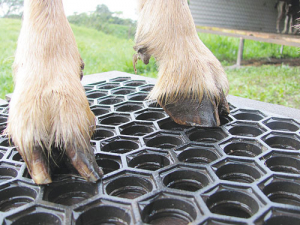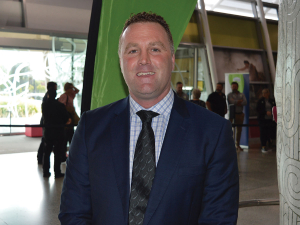When a goat has sore feet she/he will not eat properly and can lose vigour.
At six-weekly intervals, use shears and a sharp knife to trim the sidewalls of the claws and sole. Wear a glove when holding the foot, to protect against a cut by shears or knife.
Trim after rain, after the goat has walked in wet grass, or after scrubbing hoof with a nailbrush and warm water; the hoof will then be softer to cut.
You can cut safely until pink starts to shine through the white of the trimmed part; this shows you are getting near the ‘quick’, which will bleed if you cut deeper. This does not show as easily on black-hoof goats which usually have softer feet anyway, so go easy on them.
Start on a front foot, then move to the back ones; the goat is less likely to play up.
If the goat kicks hard with her back foot, pick it up by putting your hand tightly round the hamstring above the hock, then run your other hand down to the foot, take up your usual grip, and get cutting; the hamstring grip immobilises the muscles of the lower leg long enough for you to get a firm grip without hurting the goat, and once she realises you have her, she will behave better.
Debudding horns
To tell whether or not a kid has horns, feel the raised bumps between the ears on the top of the head. If they are pointed the kid will be horned; or check for whorls of hair which indicate horns.
If in doubt, leave the kid for a few days and look again. Do buck kids at younger than four days old to avert scurs.
Step 1: Clip as much of the hair as you can from the top of the kid’s head. The smell is terrible when it burns; it will grow back.
Step 2: Locate the horn buds; the skin will be tight over the site. Apply the iron to the horn bud and cut out a circle. Count the seconds; hold for 10 seconds for an average hot iron. To keep the kid immobile during this, clamp its neck between your knees or use a dehorning box. It helps to have someone hold the legs, especially if it’s a big kid. Be careful not to choke the kid; if necessary place your hand over its nose to hold it still; remember to give it a breathing spell once in a while.
Step 3: If the horn buds are well grown (12mm tall or bigger) they may be removed now quickly with a sharp knife, then the area cauterised with the iron. Rotate the iron to use the hottest spot. The whole circular area should be copper coloured.
Step 4: A cuddle and a drink of milk will restore the kid to its normal self. Apply charcoal powder. You can apply ice to cool the head.
• Information sourced from NZ Dairy Goat Breeders Association.









